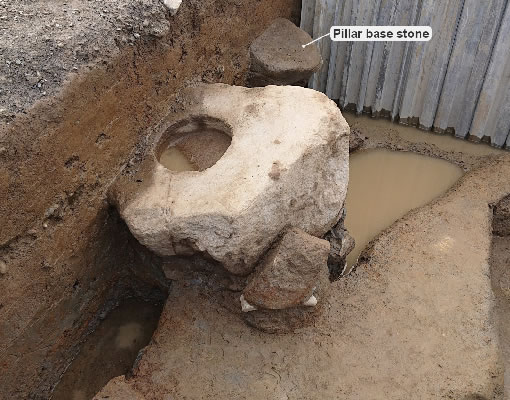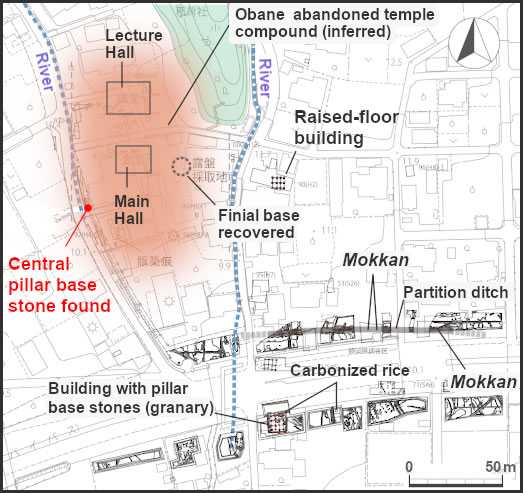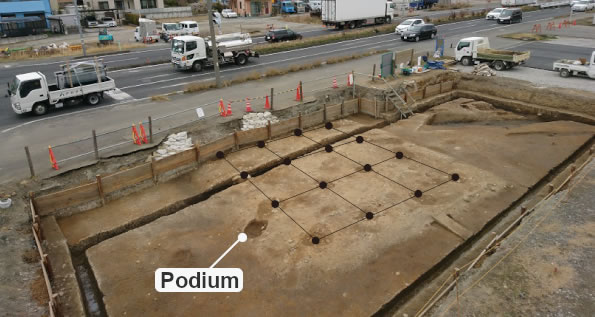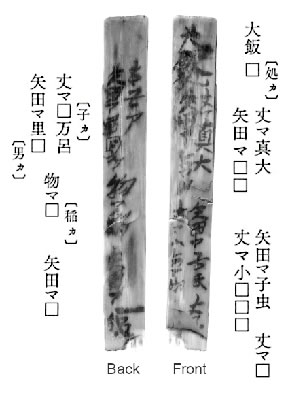Obane Abandoned Temple Site
Shizuoka City, Shizuoka Prefecture
Asuka–Heian periods (latter half, seventh century–twelfth century)

A discarded central pillar base stone, in situ The 34-cm diameter hole at center of the upper surface is the mortise hole for fitting the central shaft. A shallow depression of 70–80 cm diameter, centering on the hole, is thought to indicate the diameter of the shaft that stood atop the stone. The stone’s sides were but roughly shaped, forming an irregular quadrangle. The weight is 820 kg. Another pillar base stone is visible to the rear of the central stone. Adapted from Hakkutsu sareta Nihon rettō 2022 [Excavations in the Japanese Archipelago, 2022] (Bunkachō [Agency for Cultural Affairs], ed., Kyodo News, 2022).

Plan of the distribution of excavation precincts It is thought that in the Nara period, a district office was built on the eastern side of the temple. Adapted from Hakkutsu sareta Nihon rettō 2022 [Excavations in the Japanese Archipelago, 2022] (Bunkachō [Agency for Cultural Affairs], ed., Kyodo News, 2022).

District headquarters’ granary (from the southwest) After digging a depression (as groundwork in preparation for construction), a podium of pounded earth was built as the foundation for a building. This is the first discovery for the Tōkai region of this method of construction for a district headquarters’ granary. The span between pillars was 8 shaku (approximately 2.4 m) in the direction of the roof ridge, and 7 shaku (approximately 2.1 m) in the transverse direction. Adapted from Hakkutsu sareta Nihon rettō 2022 [Excavations in the Japanese Archipelago, 2022] (Bunkachō [Agency for Cultural Affairs], ed., Kyodo News, 2022).

Round and flat eaves tiles Recovered from the inferred area of the Obane abandoned temple compound. The grain of the wooden mold used for applying the design to the face of the round eaves tile is visible. Round eaves tile diameter: Upper item, 16.5 cm; lower item, 17 cm.

Infrared photos and transcription of a mokkan (wooden document) The names of nine individuals are visible, with surnames such as Hasetsukabe (丈部) and Yatabe (矢田部) on the front, and Hasetsukabe, Yatabe, and Mononobe (物部) on the back. Adapted from Hakkutsu sareta Nihon rettō 2022 [Excavations in the Japanese Archipelago, 2022] (Bunkachō [Agency for Cultural Affairs], ed., Kyodo News, 2022).
A district headquarters granary discovered next to an Asuka period clan temple of a powerful family
A discarded pagoda central pillar base stone is recovered
The Obane abandoned temple site is the remains of an Ancient temple located in Obane, Shimizu Ward, of Shizuoka City. Record of the existence of an old temple at this location survives from the Edo period, and excavation has been carried out intermittently since 1951, with the main hall and lecture hall being discovered. From the recovery of roof tiles bearing a design of the same derivation as those from the Historic Site Kawaradera temple in Asuka Village, Nara Prefecture, it is inferred to have been established in the Asuka period (latter half, seventh century) as the clan temple of a powerful family. In 1992 the base of a finial, which is placed at the center of the topmost roof of a pagoda, was discovered during the work of cultivating farmland.
In the 2019 fiscal year, when excavation was conducted near the western side of the main hall in conjunction with the widening of a municipal road, three stones regarded as pillar bases were detected. One of these was 111 cm on its long axis by 85 cm transversely and 58 cm thick, with a flat top in the center of which was a hole 34 cm in diameter and 11 cm deep. From these characteristics it is inferred to have been, among the base stones of a pagoda, the one that supports the central shaft. It was found at a position near the edge of the temple compound, lying at a slant in an area of low ground. While the period of the temple’s abandonment is not known, from the discovery nearby of pottery from around the twelfth century, the temple is thought to have already been in ruins at that time, and the central stone was discarded along with the other base stones that were no longer needed. As the finial base had previously been discovered at a point to the east of the main hall, the pagoda had been presumed to be standing next to the main hall on its east. But as the locus of discovery of the central base stone was to the southwest of the main hall, the pagoda may have been on the main hall’s south, and the possibility of a temple layout with the pagoda, main hall, and lecture hall lined up north–south has become conceivable.
A building with base stones thought to have been a district headquarters’ official granary
When excavation was conducted from fiscal 2016 to 2019 in conjunction with the elevation of national Route 1, a building standing on pillar base stones atop a podium and a ditch were found at a spot to the southeast of the main hall. In regions outside the Kinai district, pillar base stone buildings were limited to temples or district headquarters (government offices), and as raised-floor structures had also been found nearby in previous investigations, along with the recovery of quantities of carbonized (charred) rice near the building, it is thought to have been the official granary of the headquarters of the district of Ihara in the Ancient province of Suruga. From the accumulation near the podium of Kōzushima-Tenjōsan tephra volcanic ash, which fell from an eruption in the year Jōwa 5 (838), it is seen that construction predated that event. Further, from chronological dating of the carbonized rice and from the recovered artifacts, the granary is thought to have been built at the start of the ninth century, and then destroyed by fire in the tenth. The ditch detected on the northern side of the granary extends in a straight east–west line, and four mokkan (wooden documents) inferred to belong to the Nara period were recovered from the ditch. From its position relative to the raised floor building, it is regarded as a ditch partitioning the interior of the district headquarters.
From the results of these investigations, it is seen that at a location adjacent to a clan temple erected by a powerful family in the Asuka period, a district headquarters was built and the vicinity became the base of government in the Nara period. As background, the existence of a locally powerful family that built the temple, and was later entrusted with the position of district supervisor, can be imagined. (Koizumi Yūki/Katsumata Naoto)

